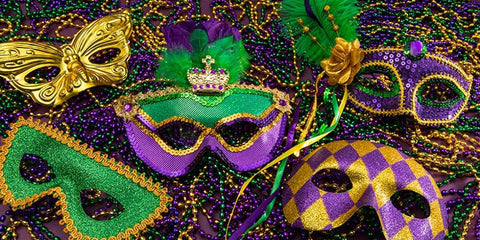The History of Mardi Gras

Everyone loves Mardi Gras. And if you’re reading this and thinking that you don’t like Mardi Gras, then it’s safe to say that you’re probably not going to the right parties. Mardi Gras involves some of the best things in life: booze, beads, and making memories that won’t actually be remembered. But how exactly did this tradition come to be?
Although it’s rather common knowledge that Mardi Gras happens around Lent, it may come as a surprise that Mardi Gras itself is a Christian holiday. Or, shall we say, that’s what it’s supposed to be. Because let’s be honest: nothing holy happens at Mardi Gras celebrations. At least none of the Mardi Gras parties that we’ve been to.
That’s why we had to dig even further into the history of Mardi Gras to learn that although the festivities were incorporated into the Christian faith, Mardi Gras started as a pagan celebration of spring and fertility. Sounds about right.
The transition from Mardi Gras being purely pagan happened when Christianity made its way to Rome. Instead of trying to completely abolish Mardi Gras from the culture, religious leaders thought it’d be easier to incorporate it within the faith –– right before Lent. If ya can’t beat ‘em join ‘em, right?
Mardi Gras traditions as we know them today were inspired by this fascinating evolution and have now become a mainstay of American culture. As for its name? “Mardi Gras” quite literally means “Fat Tuesday” in French (it actually says “Tuesday Fat,” but we can all agree that doesn’t sound as cool).
Before people had refrigerators and shit, food couldn’t be stored for long. So in the days leading up to Lent, people would binge on all of the food in their homes in preparation for 40 days of fasting –– or at the very least, not eating meat. This celebration of indulgence added to the existing debauchery inspired by the original pagan Mardi Gras, and from there the rest is history.
Well, technically it became history when the French brought Mardi Gras here to America in 1699. Then the Spanish took over New Orleans –– where the Mardi Gras parties had been happening each year –– and banned them in what can only be described as the biggest buzzkill there ever was. But lo and behold, Louisiana became its own state again in 1812 so it was out with the party poopers and in with the partying.
It took over a decade to get the show on the road, so in 1827 a group of students took matters into their own hands. After seeing elaborate Mardi Gras celebrations in Paris, the students threw on some colorful Mardi Gras attire and danced throughout the streets. It took another decade after that for the first official New Orleans Mardi Gras parade to happen, and the rest we can — actually, this time — say is history.
Mardi Gras is celebrated literally everywhere across the country nowadays, but NOLA will always be the OG when it comes to Mardi Gras. Hell, it’s even a legal holiday down there. For us Chivers and Chivettes who don’t live in New Orleans, we have to deal with calling in sick at work or playing hooky. But hey, all is fair in love and day drinking.
We did a hell of a lot of research to dive into Mardi Gras traditions — so much research that we could write a damn dissertation — but that would be no fun. So we did what we do best: made some pretty dope t-shirts. Check out our Fat Tuesday and Bill Murray Mardi Gras shirts for men and women, and prepare for a Mardi Gras season that’s absolutely lit.
P.S. As for the tradition of women showing their, ah, gifts to receive beads? Apparently, that’s not in the true history of Mardi Gras — it’s just a drunken bonus. Duly noted.


